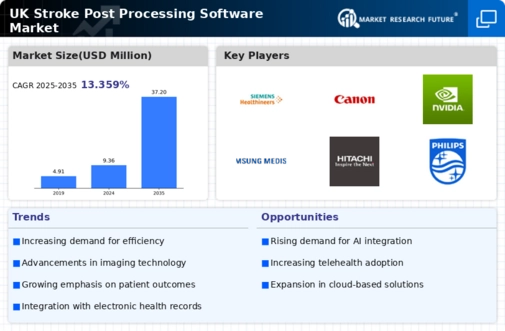Rising Incidence of Stroke Cases
The increasing prevalence of stroke cases in the UK is a primary driver for the stroke post-processing-software market. According to the Office for National Statistics, stroke remains one of the leading causes of death and long-term disability in the UK. This alarming trend necessitates advanced diagnostic tools and software solutions to enhance patient outcomes. As healthcare providers seek to improve their stroke management protocols, the demand for sophisticated post-processing software is likely to rise. The stroke post-processing-software market is expected to witness substantial growth, potentially reaching a valuation of £200 million by 2027, driven by the urgent need for effective treatment and rehabilitation solutions.
Technological Advancements in Imaging
Technological innovations in imaging modalities, such as MRI and CT scans, are significantly influencing the stroke post-processing-software market. Enhanced imaging techniques provide clearer and more detailed visuals, which are crucial for accurate diagnosis and treatment planning. The integration of advanced algorithms and software tools allows for better analysis of imaging data, facilitating timely interventions. As hospitals and clinics in the UK adopt these cutting-edge technologies, the demand for compatible post-processing software is expected to surge. This trend indicates a potential market growth of approximately 15% annually, as healthcare facilities strive to leverage technology for improved patient care.
Growing Awareness of Stroke Prevention
There is a notable increase in public awareness regarding stroke prevention and management in the UK. Campaigns aimed at educating the population about stroke symptoms and risk factors are leading to earlier diagnosis and treatment. This heightened awareness is driving healthcare providers to seek effective post-processing software that can assist in the timely analysis of stroke cases. As more individuals seek medical attention promptly, the demand for software that supports rapid decision-making is likely to grow. This trend may contribute to a 10% increase in the stroke post-processing-software market as healthcare systems adapt to the changing landscape of patient care.
Regulatory Support for Advanced Technologies
Regulatory bodies in the UK are increasingly supportive of innovations in medical technology, which is beneficial for the stroke post-processing-software market. Streamlined approval processes for new software solutions encourage developers to introduce advanced tools that enhance diagnostic accuracy and treatment efficacy. This regulatory environment fosters competition and innovation, leading to a wider array of options for healthcare providers. As a result, the market is expected to expand, with an estimated growth rate of 12% annually, as stakeholders capitalise on the opportunities presented by supportive regulations.
Increased Investment in Healthcare Infrastructure
The UK government has been actively investing in healthcare infrastructure, which is positively impacting the stroke post-processing-software market. Initiatives aimed at modernising hospitals and enhancing diagnostic capabilities are creating a conducive environment for the adoption of advanced software solutions. With funding allocated for the development of stroke units and rehabilitation centres, healthcare providers are more inclined to invest in post-processing software that can streamline workflows and improve patient outcomes. This investment trend suggests a robust growth trajectory for the market, with projections indicating a potential increase in market size by 20% over the next five years.




















Leave a Comment